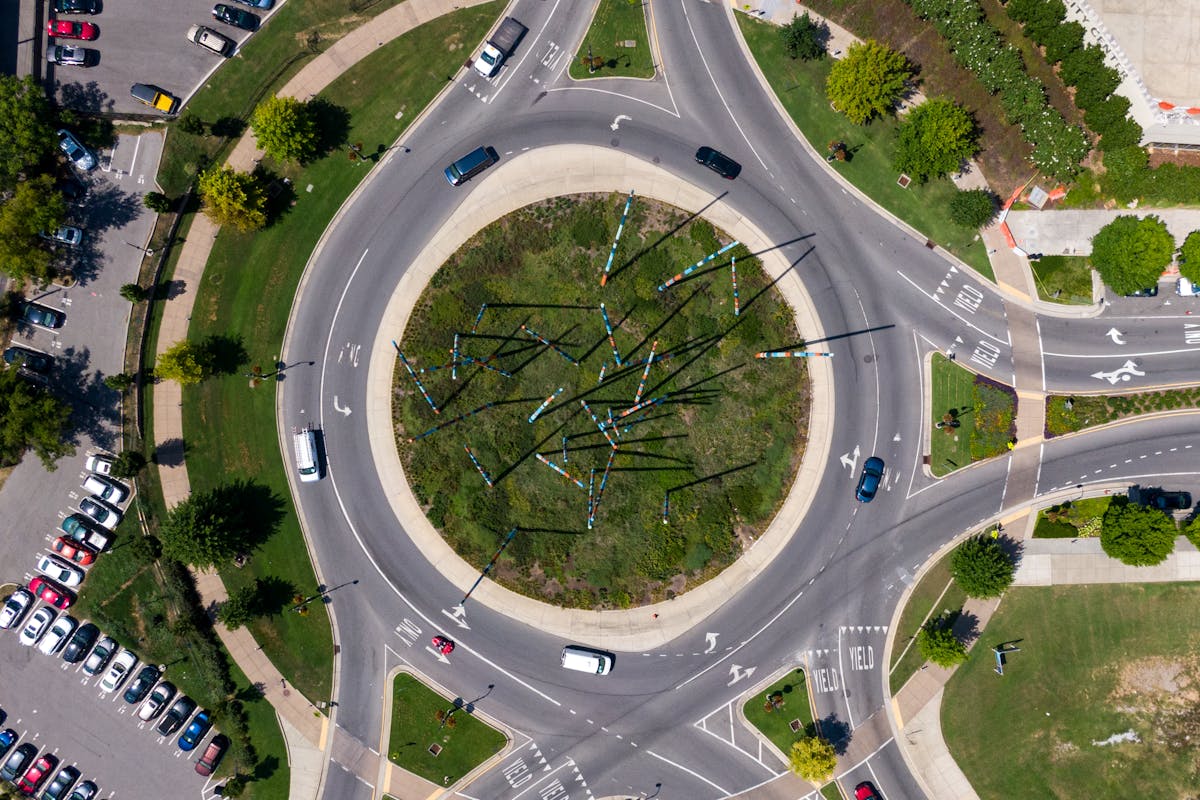The debate over roundabouts and their role in intersection safety is a significant one. Roundabouts, characterized by their circular design requiring drivers to yield to traffic rather than abruptly stop, have been statistically shown to minimize severe traffic accidents. However, the extensive impact of these structures, particularly in relation to traditional intersections, remains a fertile ground for discussion. As we consider the future of traffic management, the efficacy of roundabouts in reducing fatal crashes, injury accidents, and enhancing overall safety, certainly warrants our attention.
Understanding Roundabouts: Basics
Roundabouts, often perceived as a mere traffic novelty, are in fact an essential element in road infrastructure contributing markedly to intersection safety. Delving into the roundabout history, its initial inception was marked by the need for a traffic solution that could handle a high volume of vehicles without the necessity for traffic signals.
The primary roundabout benefits lie in their ability to reduce the speed and severity of collisions. By design, roundabouts force drivers to slow down and yield to traffic before entering, thereby reducing the likelihood of high-speed crashes. Additionally, roundabouts eliminate head-on and high-speed right-angle crashes, the types of accidents most likely to result in severe injury or fatality.
From an operational standpoint, roundabouts facilitate better flow of vehicles, reducing congestion and improving overall traffic efficiency. They can handle high levels of traffic with less delay than most signalized or stop-controlled intersections.
Roundabouts also have an environmental advantage as the smooth flow of traffic reduces vehicle idling, and consequently, emissions. This makes them a viable solution in the quest for more sustainable and safer road infrastructure.
Roundabout Design and Structure
In the domain of intersection safety, the intricacies of roundabout design and structure play a critical role. The discussion will commence with an analysis of the basic principles that underpin roundabout design, which serve as the foundation for understanding various types of roundabouts. Finally, we will explore how safety can be greatly enhanced through strategic design choices, thereby highlighting the importance of this aspect in roundabout construction and operation.
Basic Roundabout Design Principles
An astounding number of traffic accidents occur at traditional intersections, underscoring the need for safer, more effective design solutions. One such solution is the implementation of roundabouts, which demand a unique set of design principles.
The first principle to evaluate is the circulation of traffic, which should be counter-clockwise to guarantee smooth flow and reduce the risk of head-on collisions. In addition, the central island should be raised and non-traversable to guide drivers and prevent shortcutting.
Roundabout signage is another critical element, providing navigational cues and safety instructions to drivers. The signs should be clear, visible, and strategically placed to allow drivers ample time to react.
Pedestrian crossings must also be incorporated into the design, ideally situated at least one car length away from the yield line to provide a safe space for pedestrians to cross and for drivers to yield. These crossings should be well marked and ideally elevated, as speed bumps can provide an additional visual and physical cue for drivers to slow down.
Lastly, the roundabout’s diameter and entry curve radius should be carefully calibrated to slow vehicles down as they approach, facilitating safer merging and existing maneuvers. These fundamental principles, when applied correctly, can greatly enhance the safety and efficiency of intersections.
Navigating Different Roundabout Types
While the overarching principles of roundabout design aim to improve safety and efficiency, it is significant that various types of roundabouts exist, each with unique structural nuances and navigational requirements.
Multi-lane roundabouts, for instance, are characterized by their multiple entry and exit points, each of which is assigned to a specific lane. Their design requires precise lane marking and clear signage to guarantee proper lane usage and maintain smooth traffic flow. The intricacy of multi-lane roundabouts can pose navigational challenges, especially for less experienced drivers or those unfamiliar with the area.
On the other hand, mini roundabouts are small in size and are often utilized in areas with limited space or low traffic volumes. Their compact design requires drivers to reduce their speed, making them a feasible option for improving safety in residential or urban areas. However, due to their smaller diameter, mini roundabouts may not be as efficient in handling larger volumes of traffic or accommodating larger vehicles, such as buses or trucks.
Understanding the structural and navigational differences of these roundabouts is essential for both drivers and traffic engineers. This knowledge aids in creating more efficient, safer road networks and equips drivers with the skills to navigate these intersections effectively.
Enhancing Safety Through Design
Roundabout design and structure play a pivotal role in enhancing road safety—a fact underscored by various studies. The inclusion of safety features such as splitter islands, central islands, and circulatory roadways minimizes the potential for head-on and high-speed collisions.
Design innovations have been instrumental in making roundabouts more intuitive and safer for all road users, including drivers, cyclists, and pedestrians. These innovations include geometric designs that slow down incoming traffic, thereby reducing the severity of potential accidents. Similarly, the installation of pedestrian crossings and cycle paths improves safety for non-motorized users.
Another safety feature is the deflection induced by the roundabout’s central island, which forces drivers to reduce their speed and pay more attention to surrounding vehicles and pedestrians. Additionally, the simplicity of movements in a roundabout—where vehicles only move in one direction—limits the possibilities for conflict points, thereby enhancing safety.

The Importance of Intersection Safety
Intersection safety emerges as a essential aspect of road traffic management, commanding serious attention from both policy makers and civil engineers. As the nexus of multiple traffic streams, intersections present a complex environment where the risks of vehicular and pedestrian accidents are heightened. Hence, the significance of intersection safety cannot be overstated.
Analyzing safety at intersections necessitates a thorough understanding of traffic flow principles and patterns, as well as the behavioural tendencies of drivers and pedestrians. Importantly, effective intersection design should facilitate efficient movement while minimizing collision risks. This involves strategic placement of traffic control devices, optimized lane allocation, and careful consideration of sight distances.
Furthermore, pedestrian safety — an integral component of intersection safety — demands special consideration. This includes providing safe crossing paths, adequate crossing times, and clear visibility. Pedestrian safety features must be seamlessly integrated into the overall intersection design, promoting a harmonious interaction between vehicles and pedestrians.
Roundabouts Vs Traditional Intersections
How do roundabouts measure up against traditional intersections regarding safety and efficiency? Roundabouts have notable advantages over their traditional counterparts, particularly with respect to safety. The Insurance Institute for Highway Safety (IIHS) reports that roundabouts reduce fatal crashes by 90% and crashes resulting in injury by 76%, compared to traditional stop sign or signal-controlled intersections.
This safety enhancement can be attributed to several roundabout advantages. To begin with, vehicles move in the same direction, reducing the likelihood of head-on and high-speed right-angle crashes. Additionally, pedestrian safety is improved as they only need to focus on traffic from one direction.
However, traditional intersections are not without their disadvantages. The complexity of multiple traffic directions can lead to confusion and accidents. Moreover, their dependency on traffic signals can contribute to inefficiencies, such as unnecessary stops and delays, which increase fuel consumption and emissions.
How Roundabouts Improve Traffic Flow
Roundabouts, characterized by their circular layout and yield-at-entry traffic management, contribute markedly to the enhancement of traffic flow. Their efficient operation is evidenced in their capacity to reduce traffic congestion by promoting continuous movement, negating the need for traffic signal stops. Additionally, the unique engineering of roundabouts inherently increases roadway capacity, accommodating higher volumes of vehicles without compromising safety.
Efficiency of Roundabouts
Ever wondered why traffic seems to move more fluidly through a roundabout as compared to a traditional intersection? This phenomenon can be attributed to the superior roundabout efficiency, which is built into their design and functioning.
At a rudimentary level, the roundabout’s efficiency stems from its continuous flow of traffic, which contrasts sharply with the start-stop nature of conventional intersections. The circular design of roundabouts guarantees an uninterrupted traffic stream, resulting in a higher capacity and lower delay than traffic-signal systems.
Furthermore, roundabouts exhibit a higher degree of traffic management efficacy. This is primarily due to ‘yield-at-entry’ control, where incoming drivers yield to circulating traffic. This policy not only balances traffic volumes efficiently but also minimizes the need for traffic signal equipment, translating into reduced operational and maintenance costs.
Another vital aspect is the reduction in speed at roundabouts. The geometric layout compels drivers to slow down, facilitating safer and more predictable movements. This controlled velocity indirectly boosts efficiency by reducing the likelihood of severe crashes and consequent traffic disruptions.
Reducing Traffic Congestion
Building on the superior efficiency of roundabouts, it becomes apparent that they also play a significant role in reducing traffic congestion. This is largely due to their continuous flow design, which eliminates the start-and-stop nature of traditional intersections. This design directly contributes to traffic calming, a concept that aims to slow down vehicular speeds, thereby improving safety and minimizing congestion.
Roundabouts also prioritize pedestrian access, another factor that indirectly affects traffic congestion. Pedestrians using roundabouts have fewer lanes to cross, and with traffic being slowed, crossings are typically safer. This encourages pedestrian activity, which can lead to fewer vehicles on the road, contributing to reduced congestion.
Moreover, studies have shown that the capacity of roundabouts to handle traffic is higher than traditional intersections, particularly during peak hours. This is due to the continuous movement of vehicles, which reduces the time vehicles spend idling, consequently improving traffic flow.
Enhancing Roadway Capacity
In terms of roadway capacity enhancement, the design attributes of roundabouts offer substantial advantages over conventional intersections. The primary feature of a roundabout that facilitates capacity optimization is its continuous flow of traffic. Unlike traditional intersections, roundabouts eliminate the need for traffic signals, thereby reducing stoppage time and improving traffic distribution.
The geometric design of roundabouts also contributes to their high-capacity nature. The curved paths and yield-at-entry rules slow traffic sufficiently to create gaps for easy ingress and egress. This results in a lower vehicle delay, which in turn increases the overall throughput of the intersection.
Furthermore, roundabouts’ inscribed diameter and entry width can be adjusted to accommodate a higher volume of traffic. This flexible design capability not only caters to varying traffic demands but also provides a buffer for unexpected surges in traffic volume.
Reduction of Accidents in Roundabouts
A considerable majority of traffic accidents occur at intersections, making them a focal point for safety improvements. One such improvement is the implementation of roundabouts, which have been demonstrated to markedly reduce the incidence of accidents.
Accident statistics indicate a substantial decrease in the number of accidents post-roundabout implementation. This can be attributed to the unique features of roundabouts that inherently promote safer driving conditions. For instance, vehicles in roundabouts move in the same direction, reducing the likelihood of head-on and high-speed right-angle collisions.
In addition, roundabouts influence driver behavior positively. The continuous flow of traffic necessitates drivers to reduce their speed, thereby enhancing decision-making time and reducing the risk of crashes. Moreover, the compact design of roundabouts eliminates the possibility of high-speed crashes, which are often the most fatal.
Case Studies: Roundabouts and Safety
Several documented case studies provide empirical evidence supporting the safety benefits of roundabouts we discussed in the previous section. These roundabout case studies, conducted across varied geographical locations, consistently affirm the significant reduction in traffic-related accidents post the installation of roundabouts.
In one particular case study in Washington state, the conversion of conventional intersections to roundabouts resulted in a 72% decrease in crash incidents. Similarly, a study conducted in Kansas reflected a 39% reduction in total accidents post-implementation of roundabouts. These safety statistics are indicative of the roundabouts’ ability to mitigate high-speed crashes and reduce conflict points, subsequently enhancing road safety.
Moreover, a comparative analysis of roundabout case studies from Europe and North America further validates this safety advantage. In France, roundabouts contributed to a 65% reduction in injury crashes, while in the U.S, roundabouts reduced fatal crashes by up to 90%.
Future of Roundabouts in Traffic Management
Given the compelling safety benefits of roundabouts highlighted by various case studies, their role in future traffic management systems is expected to increase considerably. Technological advancements and future innovations are likely to enhance the efficiency and safety of roundabouts.
In the domain of traffic management, roundabouts provide a solution to many of the problems posed by traditional intersections. They have a significant impact on reducing traffic congestion, improving traffic flow, and minimizing collision rates. As cities grow and traffic increases, the demand for efficient traffic management systems will rise, and roundabouts are expected to be a significant part of the solution.
In terms of future innovations, advancements in artificial intelligence (AI) and machine learning could be leveraged to optimize the operation of roundabouts. AI could be used to predict traffic patterns and adjust roundabout operations in real-time, thereby increasing efficiency and reducing congestion. Additionally, the integration of connected and autonomous vehicles into circulation will require innovative roundabout designs to accommodate these technologies.
Frequently Asked Questions
How Much Does It Cost to Construct a Roundabout Compared to a Traditional Intersection?
The cost of constructing a roundabout versus a traditional intersection varies based on factors such as design, construction materials, and location. A thorough cost analysis can provide a more accurate comparison between these two options.
What Are the Environmental Benefits of Roundabouts?
Roundabouts promote continuous traffic flow, reducing congestion and related emissions. Additionally, they contribute to noise reduction by minimizing stop-and-go traffic, thereby offering significant environmental benefits compared to traditional stop-and-go intersections.
Are There Specific Rules for Pedestrians and Cyclists at Roundabouts?
Yes, specific rules apply to pedestrians and cyclists at roundabouts. Pedestrian crossings are usually marked, and cyclists must guarantee their visibility. Approaching vehicles should yield to both pedestrians and cyclists.
How Are Roundabouts Managed During High Traffic Times or Emergencies?
During high traffic times, roundabouts are managed by maintaining continuous traffic flow, reducing congestion. In emergencies, design features facilitate clear paths for emergency response, ensuring swift and unimpeded access without disrupting overall traffic circulation.
What Kind of Maintenance Is Required for Roundabouts?
Roundabout maintenance involves regular checks on pavement condition for any damage or wear and tear. It also includes landscaping upkeep, such as trimming vegetation and clearing debris to guarantee clear visibility and safe navigation for drivers.

